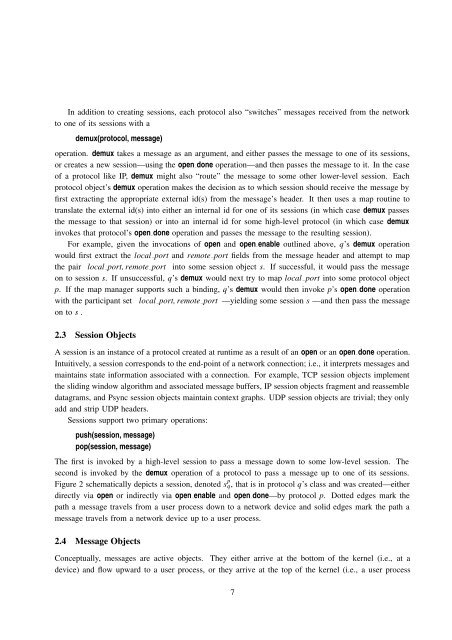The x-Kernel: An architecture for implementing network protocols - IDA
The x-Kernel: An architecture for implementing network protocols - IDA
The x-Kernel: An architecture for implementing network protocols - IDA
You also want an ePaper? Increase the reach of your titles
YUMPU automatically turns print PDFs into web optimized ePapers that Google loves.
In addition to creating sessions, each protocol also “switches” messages received from the <strong>network</strong><br />
to one of its sessions with a<br />
demux(protocol, message)<br />
operation. demux takes a message as an argument, and either passes the message to one of its sessions,<br />
or creates a new session—using the open done operation—and then passes the message to it. In the case<br />
of a protocol like IP, demux might also “route” the message to some other lower-level session. Each<br />
protocol object’s demux operation makes the decision as to which session should receive the message by<br />
first extracting the appropriate external id(s) from the message’s header. It then uses a map routine to<br />
translate the external id(s) into either an internal id <strong>for</strong> one of its sessions (in which case demux passes<br />
the message to that session) or into an internal id <strong>for</strong> some high-level protocol (in which case demux<br />
invokes that protocol’s open done operation and passes the message to the resulting session).<br />
For example, given the invocations of open and open enable outlined above, q’s demux operation<br />
would first extract the local port and remote port fields from the message header and attempt to map<br />
the pair local port, remote port into some session object s. If successful, it would pass the message<br />
on to session s. If unsuccessful, q’s demux would next try to map local port into some protocol object<br />
p. If the map manager supports such a binding, q’s demux would then invoke p’s open done operation<br />
with the participant set local port, remote port —yielding some session s —and then pass the message<br />
on to s .<br />
2.3 Session Objects<br />
A session is an instance of a protocol created at runtime as a result of an open or an open done operation.<br />
Intuitively, a session corresponds to the end-point of a <strong>network</strong> connection; i.e., it interprets messages and<br />
maintains state in<strong>for</strong>mation associated with a connection. For example, TCP session objects implement<br />
the sliding window algorithm and associated message buffers, IP session objects fragment and reassemble<br />
datagrams, and Psync session objects maintain context graphs. UDP session objects are trivial; they only<br />
add and strip UDP headers.<br />
Sessions support two primary operations:<br />
push(session, message)<br />
pop(session, message)<br />
<strong>The</strong> first is invoked by a high-level session to pass a message down to some low-level session. <strong>The</strong><br />
second is invoked by the demux operation of a protocol to pass a message up to one of its sessions.<br />
Figure 2 schematically depicts a session, denoted s p q, that is in protocol q’s class and was created—either<br />
directly via open or indirectly via open enable and open done—by protocol p. Dotted edges mark the<br />
path a message travels from a user process down to a <strong>network</strong> device and solid edges mark the path a<br />
message travels from a <strong>network</strong> device up to a user process.<br />
2.4 Message Objects<br />
Conceptually, messages are active objects. <strong>The</strong>y either arrive at the bottom of the kernel (i.e., at a<br />
device) and flow upward to a user process, or they arrive at the top of the kernel (i.e., a user process<br />
7

















